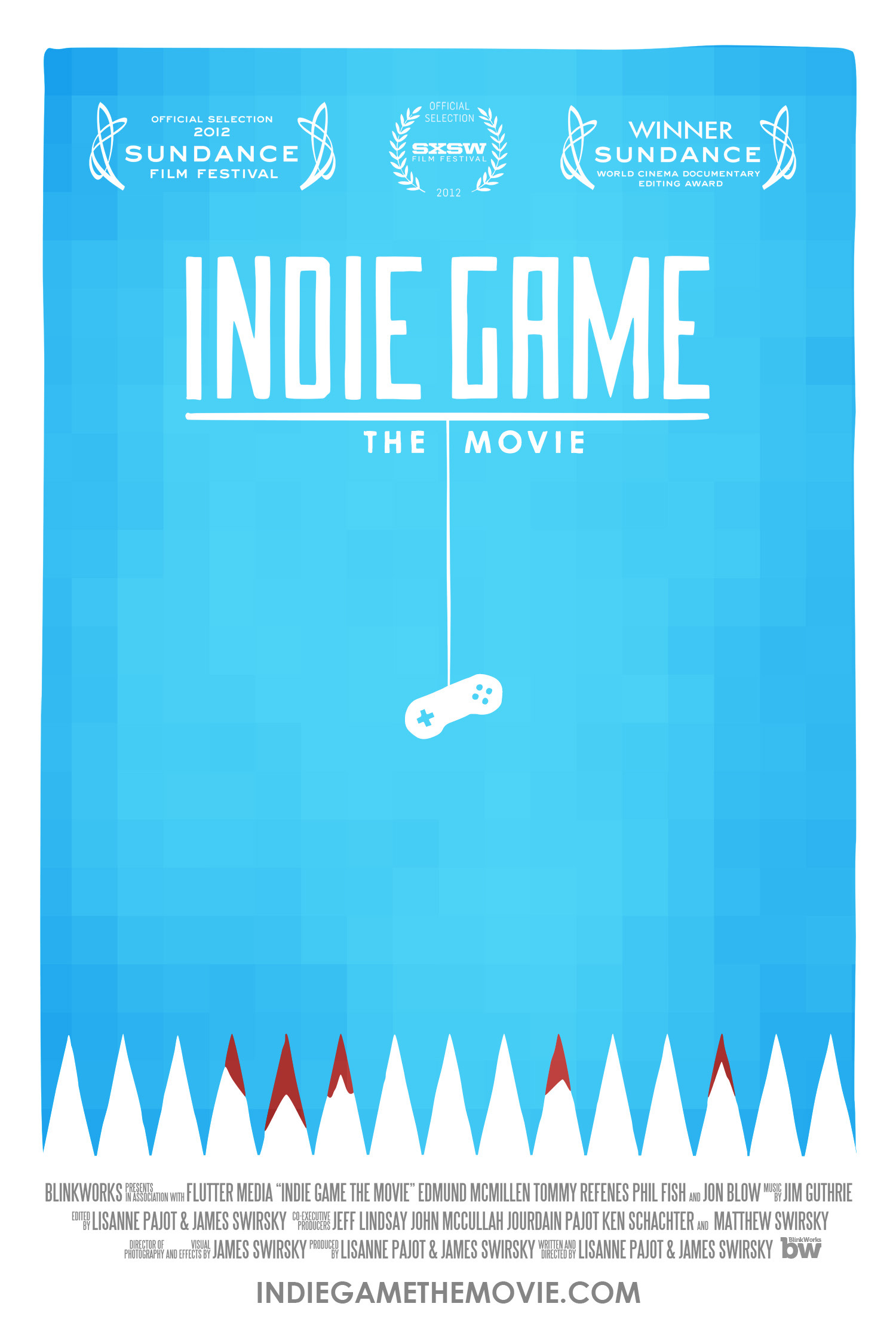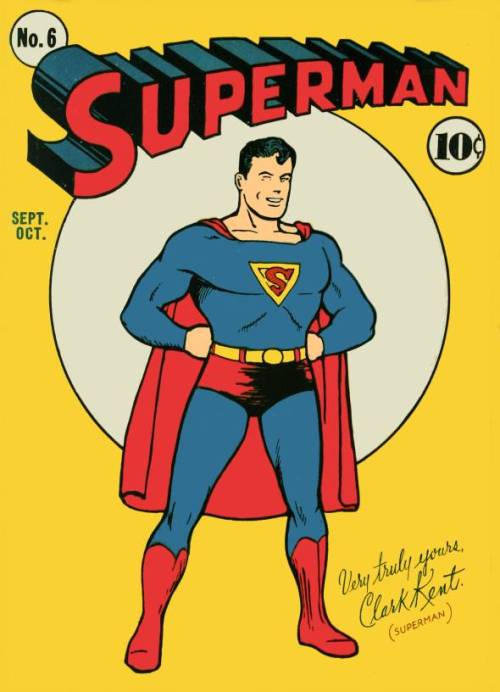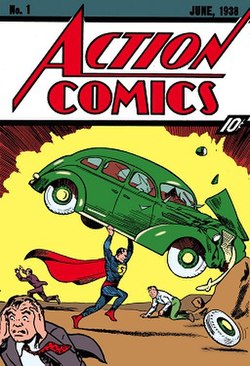 |
| God, do I love minimalist posters. |
To the average viewer of James
Swirsky and Lisanne Pajot’s Indie Game:
the Movie, the film appears to be just your typical underdog story, with
the filmmakers following four “indie game” developers – Jonathan Blow of Braid fame, Super Meat Boy developers Edmund McMillen and Tommy Referens, and
Phil Fish, the creator of the recent indie gem Fez – as they slave and strive for success. But such a simple summary of the film would
discredit what the entire documentary truly
represents, not just in the filmmaker’s decisions to show the true brilliance
of the developers on whom they focus, but also how the developers’ efforts have
an artistic meaning. The film also strives to dispel some of the
misconstrued ideas about video game culture and the people who make and play
games. For example, video games have often just been seen as a fun hobby to
many of the uninitiated masses, something to pass the time and/or alleviate
stress, but nothing to fully dedicate one’s life to. But, through their subjects, but also through
their brilliant camera and editing work, Swirsky and Pajot show that this “just
a hobby” theory is not true at all.
Video games are not just a hobby; they are a way of
life. Like any other artist, the games
are an expression of the creator’s ideals and life experiences. Therefore, these creators do not just work on
and off on these games like anyone else would treat a hobby; rather, like a true
dedicated artist, these men work endlessly to create enjoyable, meaningful, and
lasting experiences for their player. This
constant dialogue between creator and player, between artist and audience, as
well as a true elucidation of what video game culture becomes the grand truth
of the story.
 |
| Pajot (Left) and Swirsky (Right) |
Let us just focus on the work of the
developers and what their projects truly mean to them. And, to answer that, we must ask the
question, “What is an indie game?” On a basic level, an independent (or
“indie”) game is a game that is not financially supported by any big name
publisher. As opposed to the better-known
titles such as Call of Duty or Mass Effect, an indie game is either
financed by the developers themselves, or by a variety of financers that do not
represent a company. For example,
Jonathan Blow’s Braid was financed
completely by Blow himself. However,
while that may be what be what an indie game is, what an indie game means
is quite different, and the answers to such a question might vary. A developer might make an indie game in order
to make friends, to communicate a specific message with the player, or to
express themselves and all of their hopes, fears, and vulnerabilities.
 |
| Edmund, and one of his various forms of facial hair. |
Edmund
McMillen, the creative designer of the game Super
Meat Boy and one of the subjects of the film, represents this idea of
expression quite well as he describes one of his previous projects known as Aether.
The game follows a young child as he explores space with a strange,
octopus-like creature. As the boy
explores the various planets and stars, he meets many of the various planets
denizens, most of whom have problems or fears that the boy must solve. But, as the boy solves more and more the
creatures’ problems, the smaller the Earth becomes until he tries returning at
the end of the game, and the earth shatters under his weight. This concept might seem bizarre to the
outsider, but to Edmund, the game had deep artistic and psychological
meaning. According to Edmund, the game
itself is a commentary on the dangers of isolation and obsession, for the boy
is so focused on solving the creatures’ problems (which are the same problems
Edmund experienced as a child, including painful stomach aches and extreme
loneliness) that he forgets, and eventually destroys, his connection to Earth
and the real world. In many ways, this
reflected Edmund’s experiences as a child, when he lived with his grandmother due
to a poor relationship with his stepfather, and often felt isolated within
himself and his graphic artwork. To
truly convey how much this game means to Edmund, the filmmakers often compare
the gameplay of Aether to some of
Edmund’s childhood drawings, with one particular drawing of young Edmund
imagining himself in space eerily resembling the game as a whole, as if the
young Edmund knew he was going to make a game about this exact topic in the
future.
 |
| Boy, that's the most adorable psychological trauma I have ever seen. |
Even
the game focused on in the film, Super
Meat Boy, has a large significance to Edmund. The filmmakers focus on Edmund’s face, and
also use clips from the game where the eponymous character dies over and over
in the game’s death traps. Solemnly, Edmund
admits that the character is not supposed to be a light-hearted character. With no skin and constant resurrections from grisly
deaths, Meat Boy feels only pain and dread of his next demise. But, there is more to it than that. The objective of the game is to rescue Meat
Boy’s girlfriend, who is made of bandages.
As Edmund explains how Band Aid Girl completes Meat Boy and takes away
his pain, the filmmakers drop heavy hints of this having a double meaning to
Edmund, as we see a woman’s hands sewing plush toys of the two characters. It is only after this explanation that we see
Edmund’s wife, who is his moral support, and the relief to the pain and
suffering that comes with his artistic mind and pursuits and the constant work
that comes with game development. In
many ways, the game presents itself as a love letter to Edmund’s wife and all
that she does for him. When Super Meat Boy is eventually a massive
success and critically praised, this is not only a victory for Edmund on a financial basis. As Edmund tearfully admits, the idea that a
child would stay home from school to play his game and be inspired by his
life’s work – just as old games were an inspiration to him as a child – is the
ultimate victory. He was able to put
himself out in the world, and was not only accepted, but also praised and even
adored. For a person who suffered all his life with isolation and escapism,
this acceptance means everything to Edmund.
 |
| This has a deep meaning. I promise. |
But
Edmund is not the only one with something to express. To Phil Fish, his pride and joy, Fez,
is also a reflection of his childhood (which we can see through pictures of
a young Phil building Legos, which draws parallels to the blocky,
low-resolution design of Fez) and the
childlike wonder he experienced with games like Super Mario Brothers, Tetris,
and The Legend of Zelda. Thus, his tragic frustration when everything
seems to go wrong in the development process – including losing his fellow
developer and then fighting a legal battle over whether Phil can continue
making the game, his parents’ divorce, his father’s cancer scare, his loss of a
girlfriend, and even the crashing of the Fez
demo at a video game convention – not only becomes an affront and problem for
the game, but also Phil as a person.
This connection clearly illustrated in a brilliant sequence when the
filmmakers cut between gameplay footage of the Fez main character jumping from a cliff into a small pool of water
and then, just as the character hits the water, we cut to Phil below the
surface of a hotel pool, as if it was one continuous jump. In one quick moment, we know that Phil and
the game are one in the same. With this
in mind, Phil’s rather shocking declaration that he would kill himself if Fez was not released does not seem like
much of an exaggeration, since this game is
his life.
 |
| Suicide has never been more family friendly. |
We
also have Edmund’s partner and programmer Tommy Referens who, throughout the
movie, is constantly stressed and seems quite embarrassed to be in front of the
camera. Though McMillen claims Referens
is not as stressed as he is presented in the film, the filmmakers often use
Referens to show the dark side of development, along with Fish. While Edmund seems happy go lucky, Referens
works himself to death (somewhat literally as well as figuratively, as the
filmmakers constantly focus on Tommy’s poor eating habits and insulin
injections). Thus, possibility of the
game’s failure significantly weighs on Tommy since this game has been his work
for years. His sour behavior throughout
the movie is not unfounded, and his declarations to just “curl up and die” or
just “not do anything for the rest of [his] life” if Super Meat Boy does not do well clearly illustrate how much the
work means to him.
 |
| Referens |
Finally,
the same artist-work connection applies to Blow as well. Though we spend not as much time with
Jonathan in comparison to the other developers, he not only represents the
aftermath of what comes with an Indie game’s success, but also what happens
when the culture surrounding the game does not understand the meaning an artist
presents. Blow has often come under fire
for commenting on Internet threads criticizing his game (the filmmakers
representing this by not only showing Blow at his computer and the threads with
his comments, but also the negative reactions people have had to it (including
several videos and blog posts presenting Blow as a know it all or as overly
sensitive to criticism)). But, the
filmmakers choose to sympathize with
Blow’s pain and his frustration with the massive gaming audience, particularly
when they play a video of rapper Soulja Boy playing the game and being more
shallowly caught up with the time manipulation technique rather than the complex
meaning behind it. Echoes of Soulja
Boy’s review continue throughout Blow’s monologues, with a caustic “this is the
stupidest shit ever” reverberated over Blow’s saddened face. In this moment, the filmmakers truly
emphasize how horrible it is when an artist’s message is not accepted, or even considered, by the audience. For Blow, a rejection of the game is a
rejection of the self, and given Blow’s misunderstood persona in the popular
culture, it does seem he shares the same fate as his works.
 |
| My game is very complex. You probably wouldn't understand it. |
Indeed,
the culture and the surrounding video games and these men is another focus of
the film, though it is much subtler. For
if we only truly focused on the developers and their side of the story, we
would not truly understand why one game succeeds or why one fails. As mentioned, the filmmakers use constant use
of internet forums, YouTube comments, and even interview some members of video
game culture outside of development, including Gus Mastrapa of Wired Magazine, Chris Dahlen of the
video game website Kill Screen, and Brandon Boyner of the Independent Game
Festival, among others. These men, and
the numerous nameless Internet commenters represent the developers’ audience
and the more realistic side of the
story of game development. These are the
people the developers are presenting their work and themselves too, and the
filmmakers show both the good and the bad.
We have the YouTube commenters, infamous for their blunt, harsh language
as they curse out Phil Fish for his constant delays on the game. As Phil vocalizes some of the more common complaints
he hears, like “When is [Fez] coming
out?” or “Is Phil dead?” we also see the more caustic comments, as one
commenter simply states, “Fuck you, Phil Fish.
Fuck you.” Other commenters on
the popular website Reddit upload pictures of Phil with sarcastic text on them,
such as “I’m Phil Fish, and I hate my life.”
Indeed, the filmmakers often try to convey how daunting the mass
audience sometimes appears to the subjects of the film. At one game convention, before the doors open
and Phil has to present his demo for Fez
for the first time in four years, the convention goers are presented in silhouette
and in profile (commonly used through the film), giving them an eerily feeling
of being a faceless, judgmental mob.
However, when things finally go well for Phil and those at the
convention enjoy Fez, we finally see the
faces of men, women, boys, and girls as their faces light up with child-like
wonder, just as Phil intended. In these
moments, the filmmakers truly try to portray what video game culture is
actually like. While it can seem
daunting and overwhelmingly negative on the grand faceless scale of the
Internet (whose role in the culture is also emphasized in the aforementioned
use of chat rooms and forums), it is the little moments of interaction, and the
moments when a creator’s message or game truly hits with the audience that
video game culture becomes a wonderful place.
As Phil laughs and chats with the players, we plainly see the dialogue
between artist and audience that is so important in any interactive and
creative medium, and we see the communication and feeling of camaraderie that
is not often associated with the mainstream opinions of video games and the
people who play them
The
image often associated with Indie Game:
the Movie is a Super Nintendo controller wrapped around a telephone wire like
old sneakers, showing how video games are like a neighborhood with its own
culture and traditions. From this
culture, there will come artists who wish to use this medium to express
themselves. The film’s subjects all are
products of the video game culture who wish to share their life experiences
with the world, and, as the filmmakers constantly strive to show, only video
games (and indie games in particular) can be used to truly achieve this goal. When we look at clips of Edmund’s old projects
(with them ranging from bizarre, like a game about a creature who solves
problems by vomiting, to the just plain absurd (a penis fighting an enormous
vagina)), he explains to us that he has always been interested in pushing the
limits of what can be done in video games and in culture in general, and AAA games
(games produced and financed under a publisher) are too caught up in how a game
will sell. It is only through independent
games can people like the film’s subjects can produce such wild ideas and go
against the conventions and the norm. It
is only through this medium and lack of restriction that the audience can go
past the exterior, and we can truly learn what these men are about. In the final moments, in the “where are they
now” sequence of the film, the viewer watches as Jonathan, Tommy, and Edmund begins
production on new projects. And those
declarations are the firm example of why video games are an art like any other
medium, such as literature or film. No
matter how painful the experience is when one makes a game, the developers
eagerly jump into their project. For it
is not only a passion or a hobby, it is their life.









